paullmullen
Senior Member
- Location
- Wisconsin
- Occupation
- Electrical Engineer & Master Electrician
I recently received the results from the Wisconsin Master Electrician exam. As a first-timer, I didn't really know what to expect. Here are a few notes for others:
Here is how I prepared:
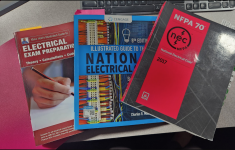
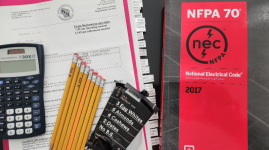
These steps are not recommendations, but they reflect my prep strategy. Maybe it will be helpful to others.
Paul
- The rumor is that the Journeyman exam is mostly code lookup and the Master exam is mostly calculations. This matched my experience on the Master Exam.
- It is a 50-question, 4-hour test. Bring any resources you want to the test as long as it is bound. Putting it in a 3-ring binder counts as binding. You are only permitted to write on the exam paper itself. No scratch paper permitted.
- If you pass, your license fee will be prorated for whatever remains of a 4-year renewal cycle. You must complete 24 hours of continuing education prior to the renewal date.
Here is how I prepared:

- Of course, I used the Mike Holt Exam Prep book. Just a note: The practice exams in the back of the book are mostly code look-up tests. The number of calculation-focused problems is limited to what is in instructional part of the book. To supplement the Holt prep with a wider variety of problems, I used Snapz training. See below.
- Of course I added the colored tabs to the NEC for fast reference. If you look carefully above, you'll see that I added some tabs at the top for a few tables I referenced frequently. I just used a typical tape label maker to make the tabs.
- As I took prep exams, I noticed that I spent a lot of time searching for numbers even if I knew generally where to look. So I used this strategy:
Yellow - Basic highlights
Pink - Used to distinguish differences, or to highlight "not" "or" "and" where it was important. (In the image below, I was highlighting Dwelling Units because I needed to remind myself that the rules are different and to look elsewhere for non-dwelling units.
Orange Circle - to circle numbers to make them easier to find.
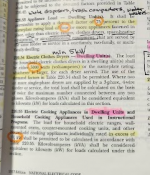
- Where Wisconsin code differs from the national code, I wrote the reference right into the book. In some cases I even glued in a copy of the Wisconsin changes when they were extensive. For instance, the Wisconsin code has a whole section on septic systems and I just glued it into the NEC book at the beginning of Article 300.
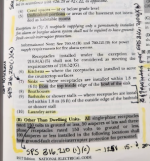
- As I made my way through the Holt guide and others, I made my own spreadsheets that implement the code as a kind of calculator. You can find mine here, but it was the act of creating them that was useful for learning.

.
If you want to use these sheets, a couple of things matter:
.
a. There are multiple tabs at the bottom for different sections.
b. The blue boxes are inputs, the white boxes are outputs. The yellow boxes are calculated by the spreadsheet but may have to be updated by the user under certain conditions.
c. It's built for the 2017 code because that's where Wisconsin is now.
d. It may have mistakes in it. I was building it as a learning strategy, not as a tool for general use.
- I remade my own version of the NEC table of contents. There is nothing wrong with the NEC's Table of Contents, but the process of creating my own helped to solidify my understanding of the structure of the codebook. You can find mine here. The sample below is from Chapter 2. Same caveats as above. I did this for my own learning and I don't claim that it is error free.
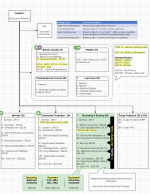
- I really wanted more practice on calculations than the Holt book offered. I found the Snapz Electrical License Prep tools to be awesome. The subscription includes all the stuff you see below. Some of it timed to drive speed, some of it untimed so that you can study as you go. It costs $149 for three months.

- I bound my calculators (5 above) and my own version of the Table of Contents (6 above) into a 3-hole notebook and brought them to the exam. They were the only two resources I used during the exam.
- I used the NEC Handbook to clarify portions of the code I didn't understand on a plain reading of the code. I had an electronic copy, so I couldn't take that to the exam.
- The Illustrated guide to the NEC looked terrific when I bought it at eBay and I liked the simple explanations in it. It had nice 1-page calculators in it. But with my own calculator work (see above) and the Holt book under my belt, it really wasn't necessary. Still, I'd recommend it if you're trying to overprepare.
- I saw everyone who loved Ugly's Electrical References. I really wanted to love it as so many others do, but I found that it was just an exercise for my reading glasses and didn't add any new understanding. (Yes, I know, it's just a reference, but I had higher hopes.)


These steps are not recommendations, but they reflect my prep strategy. Maybe it will be helpful to others.
Paul

